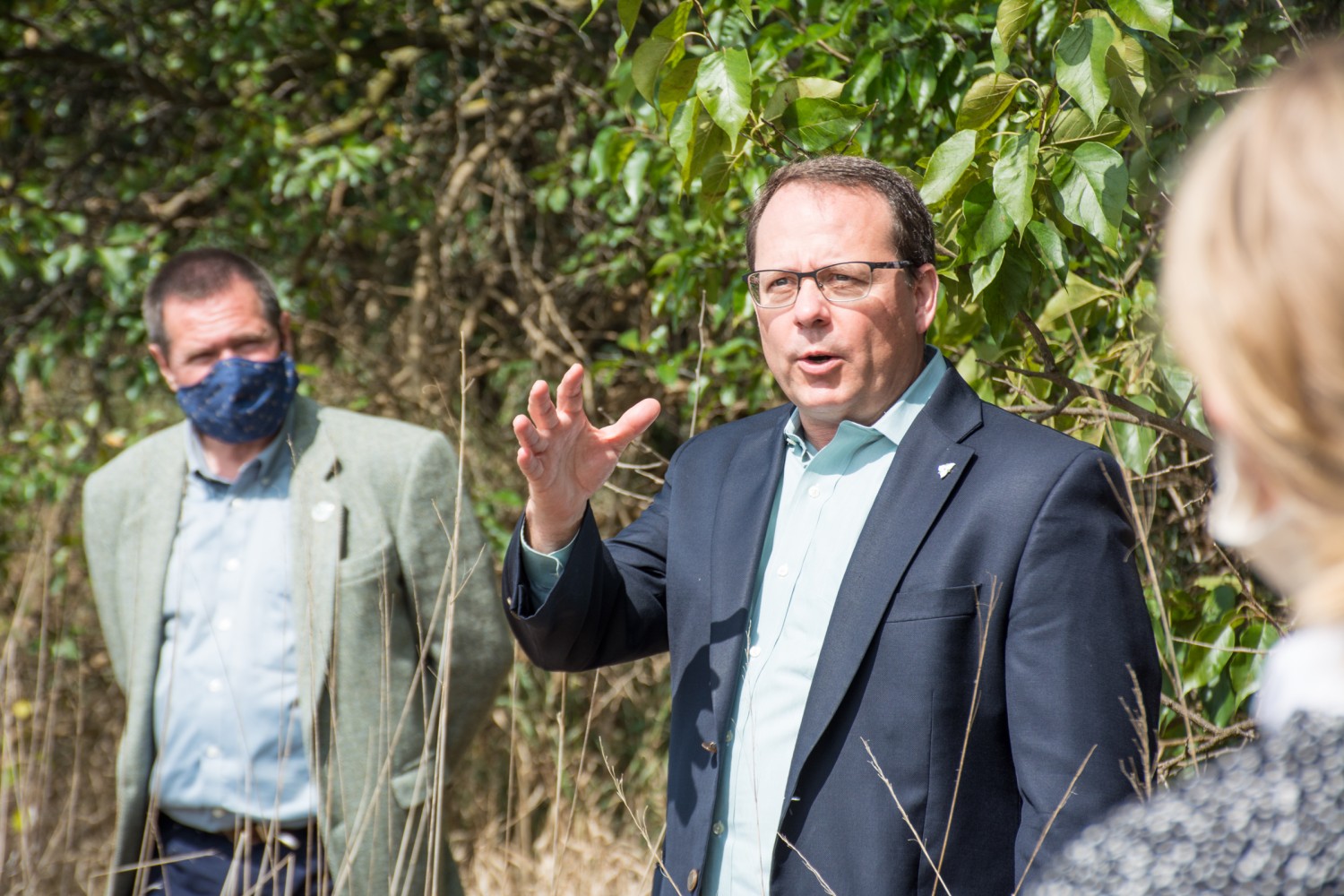
‘A highway to nowhere’: Green Party Leader, community advocates, push back against GTA West Highway
At the edge of a sun-dried soybean field in early September, Mike Schreiner is trying to save the planet.
The proposed GTA West Highway being pushed by the PC government and certain members of Caledon’s Council is planned to cut through the area, bringing with it more pavement, more cars, and more urban sprawl.
It’s exactly what the Intergovernmental Panel on Climate Change (IPCC) derided for being significant drivers of global warming, and if not brought in check, could lead to catastrophic consequences for our planet. The resulting temperature increase caused by the type of land use being pushed by Doug Ford, Caledon and the developers who stand to make a handsome profit is exactly what the province veered away from in the decade that preceded the PC election sweep in 2018, when the current premier promised builders he would open up the Greenbelt for them.
The 2018 IPCC report states that if greenhouse gas (GHG) emissions continue at the current rate, the world’s climate could warm to 1.5C above pre-industrial levels by 2040. Previous studies and projections noted severe impacts from climate change would come when the climate had warmed 2C above pre-industrial levels. However, it’s now become increasingly clear that many of those impacts (sea-level rise, drought, food scarcity) will be felt at the 1.5C level.
If there isn’t a drastic change in policies around controlling greenhouse gas emissions in critical areas of industry, including development and land use policies, we may pass the point of no return, leading to the displacement of entire nations and a flood of environmental refugees that will cost the world economy trillions of dollars. The report stressed that local governments play a key role in helping to curb temperature rise as they can alter or halt developments like sprawling subdivisions that contribute to global warming.
“This highway is a disaster from a climate perspective, it’s a disaster from a paving over farmland and being able to feed ourselves perspective, it’s a disaster from a water filtration and managing clean drinking water, and it’s a disaster from a flood perspective, and I would argue it’s a complete waste of money,” Schreiner, the Leader of Ontario’s Green Party, says.
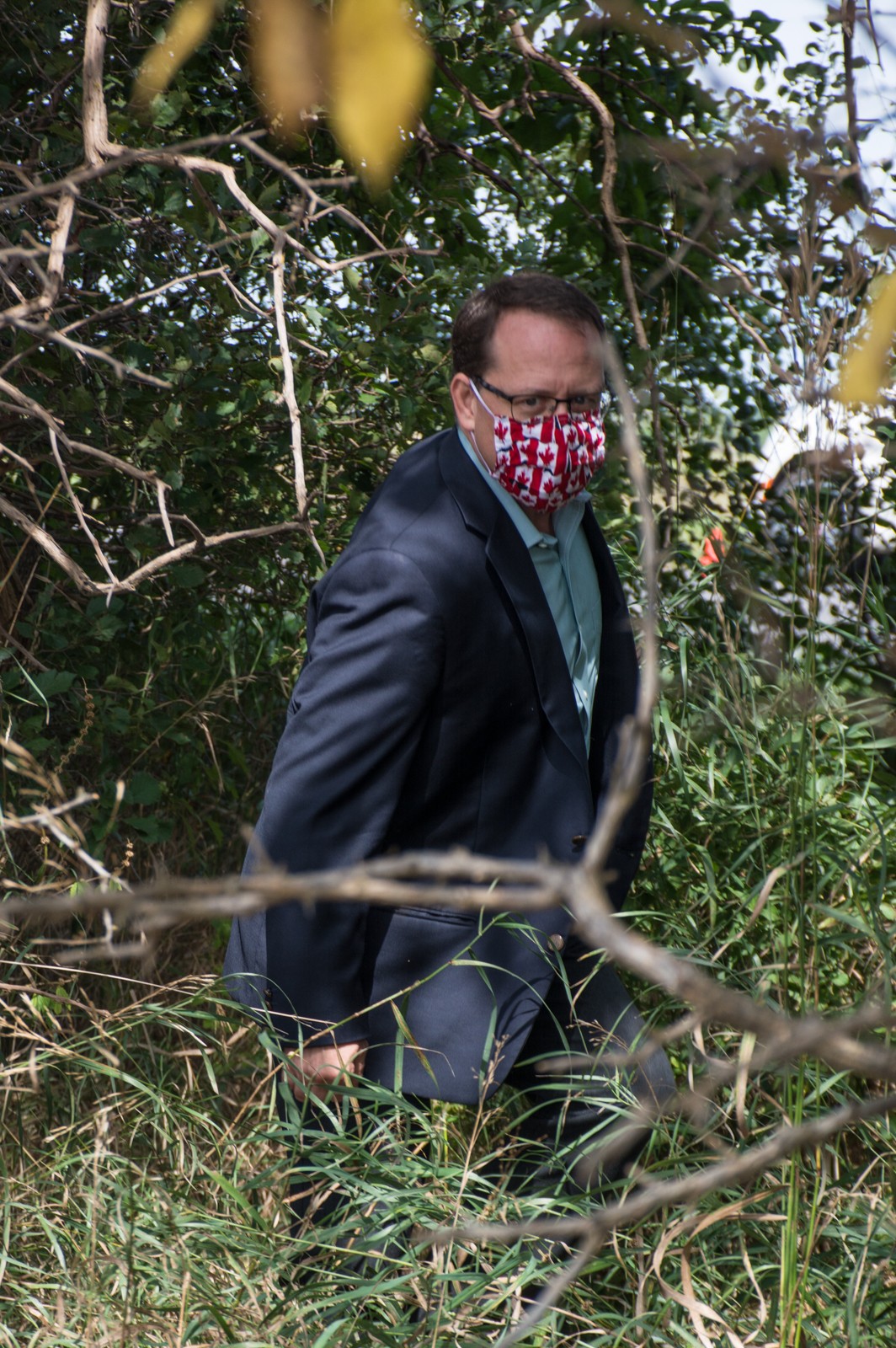
Ontario Green Party Leader Mike Schreiner is taking a strong stance against the proposed Highway 413 that would cut through significant greenspace and farmland.
Behind Schreiner stands a hedgerow of Osage Orange trees, the last remaining stand of the deciduous species in Peel. According to Stefan Wiesen, the president of the Dufferin-Caledon Green Party Riding Association, the trees were planted during the Great Depression, and while serving as a natural fence for cattle farmers, they also provided a source of income for migrant workers. The area has also been designated a heritage site by the Town of Caledon. It’s just one of the many natural features that would be destroyed by the GTA West Highway.
“It is significant, (but) obviously it’s not about the hedge, it’s about the bigger picture. What are we going to lose if we build this mega highway, what are the consequences?” Wiesen says.
Currently, the preferred route for the GTA West Highway sees the corridor running west from Vaughan through Caledon, then arcing south-west, and then down through the west side of Brampton on its way toward the 401/407 between Mississauga and Milton. This path will take the highway through or along the edge of the provincially protected Greenbelt and the Oak Ridges Moraine.
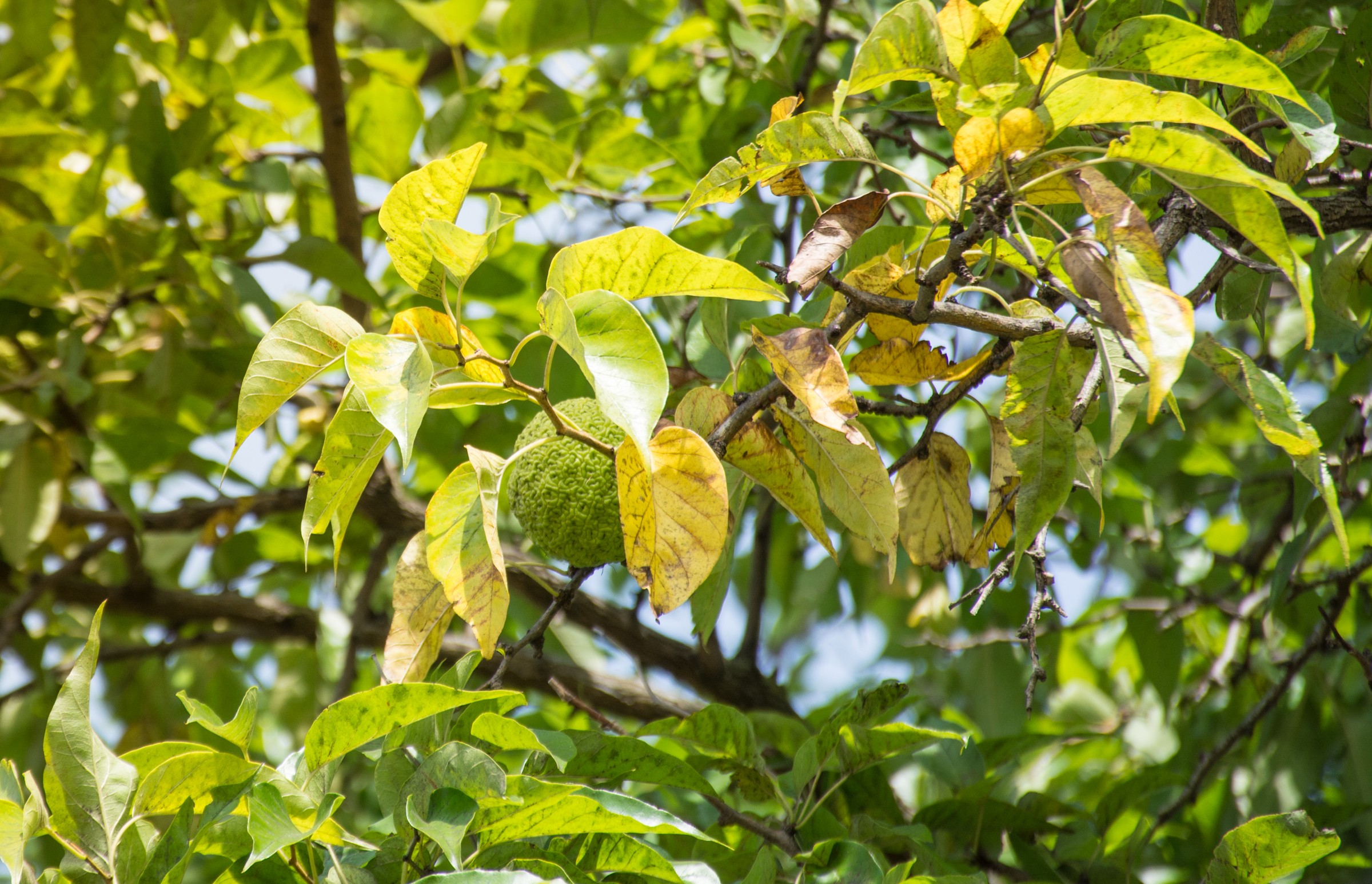
The Osage Orange tree
Since as far back as the late ‘90s, provincial governments have argued the new highway is necessary to meet the province’s future transportation demands and to reduce congestion on the GTA’s other 400-series highways. But it was cancelled by the Liberals shortly before the 2018 election that saw them, and many of their green polices and smart growth policies over the last decade shoved aside.
Now, Premier Ford, is pushing forward “shovel ready” projects he says are necessary to spark economic growth and job creation following the COVID-19 pandemic. But his mind was firmly set on the 413 Highway, long before the arrival of the novel coronavirus. Its resurrection and promises to developers, were part of his election campaign.
While the government is now pressing forward, local activist Jenni Le Forestier says this is actually the time to be taking a step back and rethinking plans laid before COVID-19 shifted everything in our lives, from how we socialize to where and how we work.
“I think it’s a terrible time to be pushing through a highway during a global pandemic. People are working from home more,” she says. “I don’t think it’s smart planning, I don’t think it’s smart growth.”
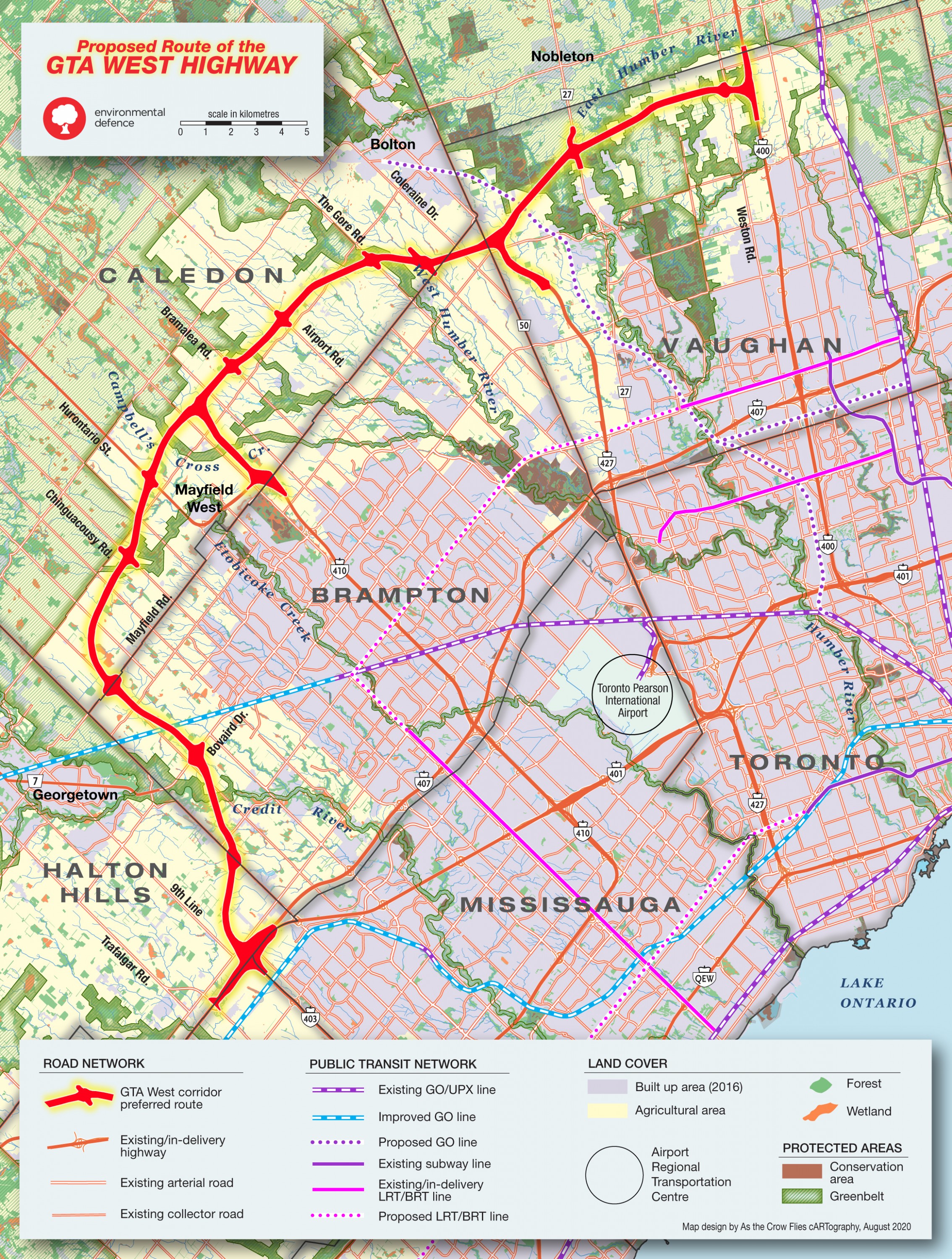
Le Forestier’s point is backed by research from major companies across the world. IBM released a survey of 25,000 American adults in early May, which showed more than 75 percent would like to continue working from home.
An independent panel formed under the previous Liberal government concluded the highway would accomplish none of the goals it was designed to achieve. In particular, analysts noted the proposed highway would do next to nothing to reduce traffic congestion on Ontario’s major highways, shaving off a meagre 30 seconds at most for the average commuter. Even with these measly time-savings, the study noted that more highways only bring more commuters and more traffic, not less.
The expert panel delivered its report in 2018, after which the Liberal government quickly shelved the idea in favour of investments in modern, green forms of transit. However, after a landslide victory that summer, Premier Ford and his PC government relaunched the project, touting the same benefits to the new highway the expert panel had just finished explaining were worthless.
With each passing month, evidence is piling up that unless the world moves quickly to address rising temperatures, we will reach the point of no return. The GTA West is only one project, but the PC’s determined push for the highway represents dangerous land use planning that will fuel decision making detrimental to any climate change goals.
The 2019 Global Assessment Report on Biodiversity and Ecosystems found that three quarters of the world’s land surface had been “significantly altered” as a result of human activity, over 85 percent of wetlands had been lost, and over one-third of marine mammals are currently threatened with extinction.
In September of last year, researchers found that North America had lost 2.9 billion birds since 1970, labelling the species decline as an “overlooked biodiversity crisis”. While that study did not address the root causes of the decline, a UN report released earlier in 2019 laid bare the fact that over one million species of plants and animals across the world are on the verge of extinction as a result of human activity like deforestation, urban sprawl, polluting land and water, and the persistent warming temperatures of climate change.
The World Wildlife Federation’s 2020 Living Planet Report found a 68 percent decline in the populations of monitored mammals, birds, amphibians, reptiles and fish between 1970 and 2016. The report put much of the blame on the earth’s poorly planned rapid urbanization.
Land across the world, but particularly in North America, has been gobbled up by private interests since the end of the Second World War, when more dense forms of urban living gave way to the mass destruction of natural ecosystems for suburban construction. Instead of living in traditional city spaces, for the last seven decades, people’s desires to have the best of rural and urban living brought together has resulted in massive deforestation, the loss of prime agricultural land and the ploughing over of sensitive watersheds.
Sprawling suburbs sending car commuters on clogged highways farther and farther away from where they work, creating one of the largest categories of emissions that account for Canada’s contribution to global warming. We are consistently among the world’s top ten worst polluters per capita.
Across the world, elected leaders and decision makers have mostly failed to address the continued destruction. This week a report from the UN Convention on Biological Diversity said a decade-long effort to save the world’s plants and animals and their habitats has been a dismal failure. The report notes that the 150 countries who agreed on the protective measures failed to meet any of the 20 different targets for protecting ecosystems. The study notes that in order to achieve these global targets critical to reduce species and habitat loss, it starts at the local level.
“Efforts to conserve and restore biodiversity need to be scaled up at all levels using approaches that will depend on local context,” the report states. “These need to combine major increases in the extent and effectiveness of well-connected protected areas and other effective area-based conservation measures, large-scale restoration of degraded habitats, and improvements in the condition of nature across farmed and urban landscapes as well as inland water bodies, coasts and oceans.”
The GTA West Highway ignores all the recommendations in these recent reports, and the devastating implications.
The proposed corridor will run adjacent to, and on top of, the Greenbelt, an environmentally protected ecosystem relied upon by many plants and animals for habitat. The green barrier surrounding Canada’s largest population cluster also serves as the healthy, sustaining, headwaters for much of the watersheds that run south to Lake Ontario. Any damage or contamination in the headwaters, eventually filters downstream. Lake Ontario is the source of drinking water for approximately 9 million people in Ontario and New York. According to Lake Ontario Waterkeepers, the lake is already the most vulnerable of all the Great Lakes as a result of human activity.
A number of threatened and endangered species rely on the Greenbelt. The GTA West Highway would run a multi-lane highway in front of this habitat, further fragmenting the natural landscape. Protected animals under Ontario’s Endangered Species Act that call the area home include a long list of amphibians, insects, birds and fish like the Jefferson salamander (endangered), the bank swallow (threatened), the barn swallow (threatened), the bobolink (threatened), the Cerulean warbler (threatened), the eastern meadowlark (threatened), the eastern wood-pewee (special concern), the Henslow’s sparrow (endangered), the monarch butterfly (special concern) and the American eel (endangered), to name just a few of the thousands of species of various life forms that will be threatened.
“Our natural heritage systems do not need a highway coming through them. We should be protecting the headwaters, we’re the waters for the GTA,” Le Forestier says.
Aside from the urbanization of the province and the loss of habitat, one of the largest threats to animals nearing extinction is the fragmentation of their habitat. Many animals move over long ranges either to feed or breed; having a road run directly through this range opens up the risk of them ending up dead on the side of a highway.
The destruction the future highway would bring, would create an environmental ripple-effect felt by humans and animals alike for decades. For Olivia Rowan, a Grade 12 student in Orangeville and climate activist, she’s trying to rally the youth voice against the Highway 413 project. She’s seen success in the past, with a climate strike she helped organize — motivated by Swedish student activist Greta Thunberg — seeing nearly 400 people attend.
“I sometimes get worried that my friends get a little bit annoyed that I’m always on them about local environmental issues, but I do think that a lot of youth, especially today, I would go so far to say, are hyper-aware of the issues that are going to be affecting their future, especially their future financially, environmentally,” she tells The Pointer. “This is not something that needs to be happening. If I’m looking forward, personally, a highway is not what I want to see going through, the future is green transportation, it’s public transportation and a highway is not going to deliver that.”

Olivia Rowan
Then why is the project moving forward?
Separate from the questionable commuter traffic benefits, the website for the GTA West Study states the highway would improve goods movement in the GTA with a multi-modal transportation corridor. Local activists believe there is an easier solution than spending hundreds of millions of dollars on a highway, and it exists with a highway that is already constructed; the 407. Despite being sold off by the province, activists suggest either buying the infrastructure back, or leasing a lane of the under-used toll route dedicated for trucking.
“We need to be moving towards a model that is based on smart growth and obviously we have to think about our carbon budgets,” states Laura Campbell, a former Green Party candidate for Dufferin-Caledon, and member of the party’s shadow cabinet as critic for natural resources and forestry. “Moving people and goods is important, but it has to be a way that respects the fact that we have a very real deadline of 2030 where we need to move toward a carbon neutral economy.”
“We’re living in climate chaos as is,” she says.
The environmental impacts of the roadway itself would destroy the local environment directly around it, but like the inevitable tsunami after an ocean earthquake, the tidal wave of sprawling urban development that would follow the highway would arguably be more destructive.
Premier Ford’s connection to the development industry has reared its head many times since he was elected in 2018, and the development interests could also be partially responsible for putting him in the Premier’s chair in the first place.
Several times during his time in office, Ford has tried to make life easier for the subdivision-building companies of the province.
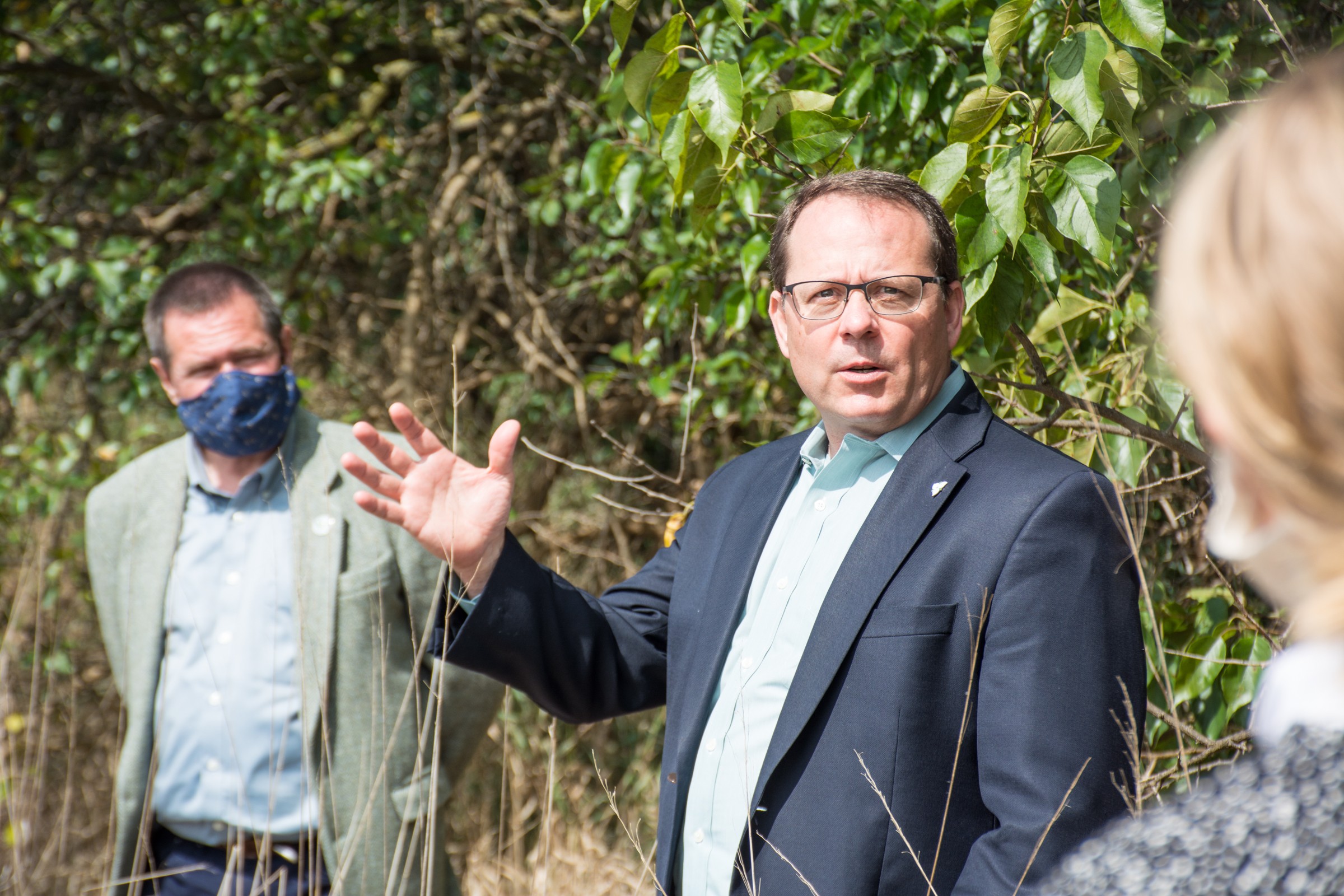
Schreiner meets with activists and community members along the route of the proposed Highway 413.
He was set to give builders a boost with Schedule 10 of the proposed Bill 66 last year, which would have given municipalities the power to override provincial protections on sensitive lands by enacting “open for business” bylaws. Following public outcry, the government backpedaled on the proposal, saying those clauses would be removed from the draft bill.
Also, Ford was infamously captured in a video ahead of the 2018 election promising developers at a private meeting in Markham that he would open up a “big chunk” of the protected Greenbelt for development, if they helped get him elected. Captured in the leaked video, Ford tells a group of men that after talking to some of the “biggest developers in the country” it was their idea and his as well: “Give us property and we’ll build and we’ll drive the costs down.”
Developers have traditionally provided the largest share of election contributions at both the provincial and municipal level. In Brampton, research has shown that some municipal officials have received as much as 80 percent of their election campaign financing from developers.
After a considerable backlash, Ford retracted the privately made statement caught on video and noted he would not open up the Greenbelt, which because of its watersheds and other important ecological features is protected by provincial legislation — a sore point for developers who have already assembled lands in and around the protected areas.
But the claimed withdrawal of his Greenbelt targeting has been contradicted by Ford’s actions in the legislature, with moves that would allow encroachment by the building industry and the aggressive push for the 413 Highway.
The goals of developers and Ford may have been sidetracked by strong public reaction, but the GTA West Corridor is an even bigger prize to the development industry players looking to build in and around the giant corridor. It would open up massive swaths of agricultural land whose future use has been in limbo for years, triggering sprawling development to the edge of the Greenbelt and possibly beyond. The highway would go against recent amendments to provincial growth legislation enacted to curb sprawl and create a much more compact, transit friendly urban footprint across Southern Ontario.
Most recently, through the guise of its COVID-19 recovery bill at Queen’s Park, the Ford government has moved to once again make it easier for developers to get shovels in the ground, environmental impacts aside.
As part of omnibus legislation, the PCs moved to “streamline” the Environmental Assessment process to make it easier for developers to get projects built faster.
The possibility of streamlining the environmental assessment process is fraught with potential problems. These studies are completed in order to detail the potential issues and challenges of such a massive project, using a variety of measures and tests. They vary in detail and scope depending on the project, with more stringent and exacting studies completed for bigger plans. The process for a major highway can take years, measuring everything from air and sound quality impacts, effects on groundwater and local waterways, the impact on thousands of species including insects, mammals, birds and fish as well as traffic levels and the benefits to the province’s transportation network.
Ecological tests have to be completed including impacts on local species, migration patterns, wetlands and potential encroachment on environmentally protected lands.
EAs are crucial measures of due diligence and ensure that residents, the environment and surrounding communities are not unfairly impacted by new development.
For Schreiner, the province would be much better off taking the millions of dollars it is using to study the highway, and the exorbitant amount it would cost to build it, and putting that money into public transit.
“People in Dufferin-Caledon need transit. People have been asking for a GO stop in Bolton for years,” he says.
“I’m calling on the Ford government to follow what the evidence and what the experts have said. If you think about it, that’s how we’ve gotten through this pandemic, we’ve followed what the scientists have said, we’ve followed what the public health experts have said, we’ve followed what the evidence has told us to do. So why not do that with this highway?”
Email: [email protected]
Twitter: @JoeljWittnebel
COVID-19 is impacting all Canadians. At a time when vital public information is needed by everyone, The Pointer has taken down our paywall on all stories relating to the pandemic and those of public interest to ensure every resident of Brampton and Mississauga has access to the facts. For those who are able, we encourage you to consider a subscription. This will help us report on important public interest issues the community needs to know about now more than ever. You can register for a 30-day free trial HERE. Thereafter, The Pointer will charge $10 a month and you can cancel any time right on the website. Thank you.
Submit a correction about this story


